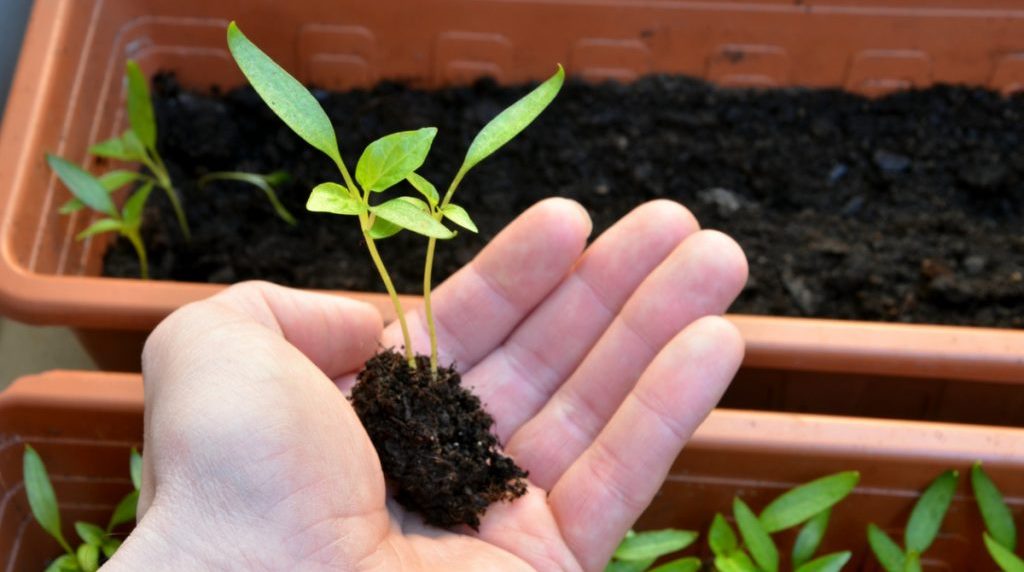 The process of transplanting cultivated seedlings from a common tank into separate containers is called picking root systems. If the seeds were originally sown in separate containers, then their movement together with a lump of land is called transshipment.
The process of transplanting cultivated seedlings from a common tank into separate containers is called picking root systems. If the seeds were originally sown in separate containers, then their movement together with a lump of land is called transshipment.
The second method is safer and more gentle for the plants themselves. In any case, the first pick of the roots is carried out after the formation of 2-3 full leaves on each of the stems. This is due to the fact that the plant has great chances to maintain strength and continue further development on new conditions.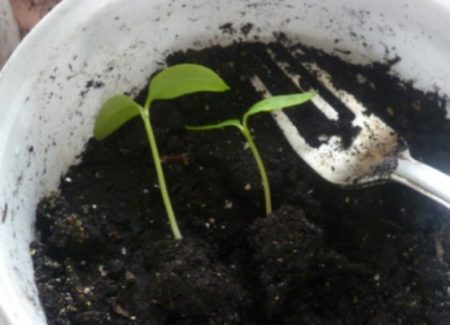
Content
How necessary is picking a seedling?
Picking plants is a mandatory process if seedlings are planted in a common container. This is due to the fact that with the further development of undivided sprouts, they will begin to obscure each other and can simply stop growing or stretch too much, making the stem itself less stable and more vulnerable, which means that the fruit yield will not be so impressive.
If the seeds were planted in small containers (about 50-100 ml), then when several full leaves appear, the seedlings should be transplanted into large containers (300-500 ml). This is because the previous conditions are no longer enough for the development of a strong root system and the growth of the bushes themselves. The decision to sow the seeds immediately in large containers is also erroneous, since a small number of roots will not be able to process all the moisture received, which means there is a risk of accumulation of excess water, its acidification and the appearance of mold.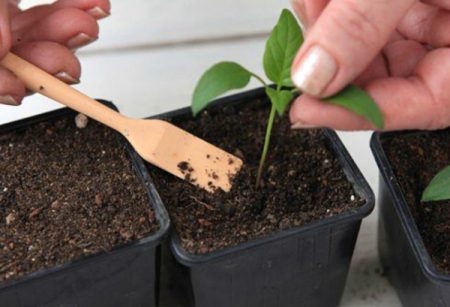
The main rule of the picking is the timeliness of the work, as well as their accuracy and care. Only then can it be expected that:
- plants will begin to grow and grow faster;
- gain additional resistance against many possible lesions and diseases;
- the root system will be more developed, which means that more nutrients will be processed correctly;
- the fruits will be large and with a balanced taste.
Before starting work, it is important to moisten the earth well, and in the process itself to use the shoulder blades so that a lump of “native” earth remains near the roots.
Optimal timing
Since separation of seedlings too early is as dangerous as too late, the work itself should be planned in advance. In the first case, seedlings may not be strong enough to begin adaptation to new growing conditions, and in the second case, too much loss of lateral roots in the system may be detrimental.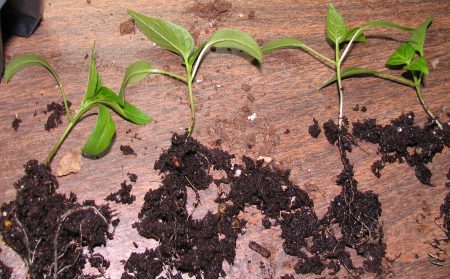
It is best to separate the seedlings into separate containers after 15 to 20 days from the moment the shoots appear. As a rule, it is precisely at this time that 2–3 full (not cotyledonous) leaves are formed on the stems. If there are only cotyledonous leaves, the work itself should be postponed, since the root system is still too weak and will not tolerate any interventions.
Features of the influence of the lunar calendar in 2018
Since pepper is a nightshade crop, productivity depends on the state and degree of development of the root system, which means that a carefully and timely picking is one of the main stages of the entire process of growing fruits. Among many experienced gardeners, it is generally accepted that the observed phase of the moon has its own separate effect on all living objects, at least partially consisting of water, including plants.
In the waning moon phase, the nutrients consumed by the plant accumulate in the root part, thereby provoking their development and even greater strengthening. Due to this, this period is neutral for the procedure of picking pepper seedlings, but obliges the work itself to be carried out as carefully as possible.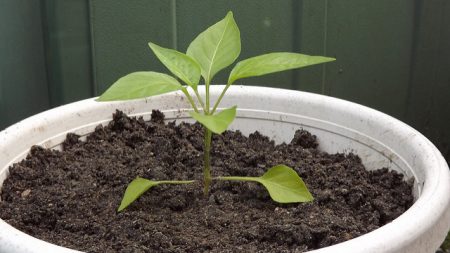
The full moon is distinguished by the movement and accumulation of micronutrients and forces in the terrestrial part of the plants, which means that the roots at this time become more vulnerable and painful to tolerate any interventions, including the separation of plants for further transplantation. It is better to transfer the work itself to a more favorable period.
The stage of the growing moon is characterized by the most active development and prosperity of plants. In this period, most of the forces and nutrients are redirected from the roots to leaves, flowers and ovaries. This phase of the moon is the most favorable stage for picking pepper seedlings. At the same time, it is considered that even when injured, plants are able to quickly recover and continue further development.
The phase of the new moon is considered the most unfavorable for plants, since their growth and development is suspended, and the forces and moisture accumulate in the roots, which are extremely important not to destroy in any way. Diving in this case is highly discouraged.
If a picking of pepper seedlings is planned for April 2018, then the best period for carrying out the work itself is the time of the 12th - 13th, as well as the 17th - 18th and 21st - 22nd of April. In the first case, the moon will be influenced by Pisces, which means that these days are most suitable for treating plant root systems, including their picking. The second stage is favorable for working with seedlings. The third period is characterized by the patronage of Cancer, which determines its beneficial effect on the processes of picking plants for the purpose of transplanting into the greenhouse, as well as direct fertilizing of the soil.
As for planting the grown seedlings on permanent soil, the period from April 20 to 22 and 24 to April 27, and also from May 18 to 22 or 26 to 28, is most suitable for this. In any case, the soil should be warm enough, and the risk of spring night frosts returning - zero. That is why you should not rush to plant pepper in open ground in the first half of May (on the waning moon), especially with regard to the territories of the Moscow Region where stable warm weather is not yet observed.
During June, pepper planting in open ground (which is more relevant for regions with a cold climate) is recommended to be carried out on 1 - 2, 6 - 7 or 10 - 11 numbers. It is in this case that one should count on a good harvest of fruits.
Advantages and disadvantages
If the work associated with picking seedlings is carried out in a timely manner and as accurately as possible (while maintaining the integrity of the root system of each bush), then the list of important advantages of the process should include: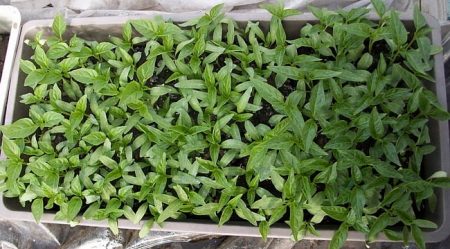
- Simultaneous sorting of seedlings. In the process, only well-grown and fully developing sprouts are selected, which means that a plot of fertile land will be used more efficiently, because damaged and too weak can not give the expected yield.
- The ability to increase the resistance of plants to fungal infections, viruses and many other diseases, as well as insect pests. This is also due to the fact that already spoiled sprouts are completely discarded, while maintaining the integrity of the rest.
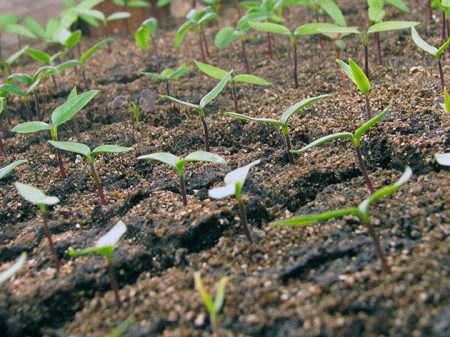
- It is thanks to picking that there is a point of growth of the main root, which in turn provokes a more active growth of lateral appendages located in the surface of the soil, where most of the useful trace elements accumulate after the demolition of solutions with fertilizers. From this, the crop itself becomes larger.
As for the shortcomings, when planning a dive of pepper seedlings, you should be prepared for the fact that:
- There is always a risk of diving too early, which will adversely affect the plants themselves.
- In the process of manual work, there is also the risk of transferring infections from diseased sprouts to healthy ones.
- The necessary care and accuracy is not always available, and this also applies to the most experienced gardeners.
- The danger is not only too early, but also too late to pick, because too many lateral roots are damaged and the plant can stop in its own development.
Step-by-step instructions for the process of diving seedlings
Even before the picking begins, it is necessary to prepare new containers and soil in which the seedlings will be transplanted. As the soil, you can use special store mixes or prepare it yourself by combining garden or garden land with peat, coarse river sand and organic fertilizer, such as humus or compost. For 9 - 10 liters of this composition, it is recommended to add one and a half tablespoons of superphosphate, as well as slightly less potassium sulfate and ammonium nitrate. At the bottom of the tanks themselves there should be drainage that does not allow excess moisture to stagnate in the ground.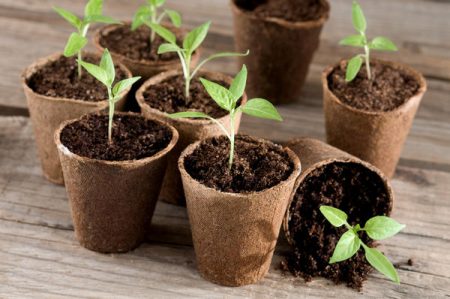
The picking procedure consists of the following sequential actions:
- Carefully removing the seedling along with a lump of earth through the use of a stick, spatula or spoon.
- In the container where the plant will be transplanted, you need to form a hole about the same size as the resulting lump of earth with roots. The walls with soil should be denser.
- Warm water is added to the recess, and then immediately put the root base of the seedling with a gentle compaction of the soil around the stem. The soil level should not be higher than that which was during the initial cultivation of sprouts.
- The transferred seedling is again watered with warm water, directing it under the root.
If the whole procedure is carried out correctly, a temporary stop in the development of plants should stop after a week. Most clearly this will be indicated by the appearance of new green leaves on the stems.
Important Tips
To get the desired result, you should prepare in advance for a picking of pepper seedlings. First of all, this concerns the use of blades so that the maximum amount of land near the roots is preserved by a lump. The second important point concerns the advance preparation of the soil - 2 to 3 days before transplanting, the soil must be watered abundantly. At the same time, the soil itself must be loose, light and necessarily fertilized. It is better if it consists of identical parts of ordinary garden land, humus, large river sand and peat.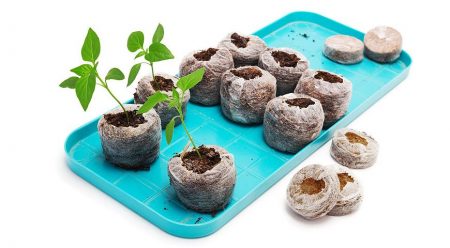
At the bottom of the containers where the seedlings will be transplanted, there must be a drainage layer. It is he who provides the discharge of excess moisture and does not allow the oxidation of the soil itself.
Another important nuance concerns maintaining the vertical position of the root system when transplanting into new soil. This is due to the fact that it is not typical for pepper stalks to form lateral appendages that grow into a root, which means that the bush itself will not be able to grow correctly. The soil should not cover the stem more than it was during the initial growth of the sprouts, since the lack of lighting will only weaken the plant and lead to fewer fruits.




 Calorie pepper stuffed with meat and rice - BZHU per 100 grams
Calorie pepper stuffed with meat and rice - BZHU per 100 grams Gorky pepper - the best varieties for open ground
Gorky pepper - the best varieties for open ground Hot pepper seeds - the best varieties for open ground and reviews
Hot pepper seeds - the best varieties for open ground and reviews Capsicum tincture for hair - how to use and reviews
Capsicum tincture for hair - how to use and reviews